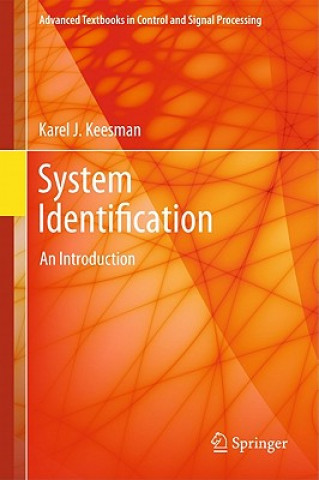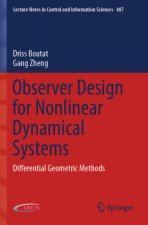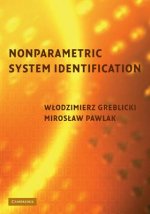
Kód: 01210326
System Identification
Autor Karel J Keesman
System Identification: an Introduction shows the (student) reader how to approach the system identification problem in a systematic fashion. Essentially, system identification is an art of modelling, where appropriate choices have ... celý popis
- Jazyk:
 Angličtina
Angličtina - Vazba: Brožovaná
- Počet stran: 323
Nakladatelství: Springer London Ltd, 2011
- Více informací o knize

Mohlo by se vám také líbit
-

System Identification
3292 Kč -

Aircraft System Identification
3143 Kč -

Identification of Dynamic Systems
3109 Kč -

Nonlinear System Identification
2355 Kč -

System Identification and Adaptive Control
3289 Kč -

Detection and Estimation Research of High-speed Railway Catenary
3289 Kč -

Piano Sonata in A Major, Op. 101
3553 Kč -

Air and Missile Defense Systems Engineering
5255 Kč -

Who Was King Tut?
173 Kč -

Arduino Project Handbook, Volume 2
597 Kč -

Predictive Control for Linear and Hybrid Systems
1945 Kč -

Introduction to Passive Radar
4305 Kč -

Bridges (New edition)
706 Kč -

Frida Kahlo Masterpieces of Art
463 Kč -

Essentials of Finance and Accounting for Nonfinancial Managers
642 Kč -

Psychedelic Mysteries of the Feminine
424 Kč -

Feedback Control of Dynamic Systems, Global Edition
2574 Kč -

Indestructibles: Baby, Let's Count!
149 Kč -

Little Hippo
242 Kč -

Soldiers and Silver
1519 Kč -

Observer Design for Nonlinear Dynamical Systems
4335 Kč -

Flowers of Buffoonery
324 Kč -

Web Scraping with Python: Data Extraction from the Modern Web
1571 Kč -

Avatar: The Last Airbender -- The Bounty Hunter and the Tea Brewer
372 Kč -

The Goal
708 Kč -

Nonparametric System Identification
2014 Kč -

Star Wars: The Force Awakens
290 Kč -

Ballistic Missile Defense Technologies
1058 Kč -

Children of Hurin
2012 Kč -

History of Western Philosophy
690 Kč -

Ship or Sheep? Student's Book
639 Kč -

Understanding Cryptography
1252 Kč -

Introduction to Topological Manifolds
1772 Kč -

Musical Brain - and Other Stories
731 Kč -

JavaScript and JQuery - Interactive Front-End Web Development
787 Kč -

Strapdown Inertial Navigation Technology
4530 Kč -

Sliding Mode Control In Engineering
10729 Kč -

International Code of Signals
424 Kč -

Sára Kniha druhá
176 Kč -

Eine »Wissenschaft vom Menschen«.
2475 Kč -

Trilogía Reina roja (Pack con: Reina roja # Loba negra # Rey blanco)
848 Kč -

Architektura 58–89
2512 Kč
Dárkový poukaz: Radost zaručena
- Darujte poukaz v libovolné hodnotě a my se postaráme o zbytek.
- Poukaz se vztahuje na celou naši nabídku.
- Elektronický poukaz vytisknete z e-mailu a můžete ihned darovat.
- Platnost poukazu je 12 měsíců od data vystavení.
Více informací o knize System Identification
Nákupem získáte 265 bodů
 Anotace knihy
Anotace knihy
System Identification: an Introduction shows the (student) reader how to approach the system identification problem in a systematic fashion. Essentially, system identification is an art of modelling, where appropriate choices have to be made concerning the level of approximation, given prior system s knowledge, noisy data and the final modelling objective. The system identification process is basically divided into three basic steps: experimental design and data collection; model structure selection and parameter estimation; and model validation, each of which is the subject of one or more parts of the text. §Following an introduction on system theory, particularly in relation to model representation and model properties, the book contains four parts covering:§· data-based identification non-parametric methods for use when prior system knowledge is very limited;§· time-invariant identification for systems with constant parameters;§· time-varying systems identification, primarily with recursive estimation techniques; and§· model validation methods.§A fifth part, composed of appendices, covers the various aspects of the underlying mathematics needed to begin using the text.§The book uses essentially semi-physical or grey-box modelling methods although data-based, transfer-function system descriptions are also introduced. The approach is problem-based rather than rigorously mathematical. The use of finite input output data is demonstrated for frequency- and time-domain identification in static, dynamic, linear, nonlinear, time-invariant and time-varying systems. Simple examples are used to show readers how to perform and emulate the identification steps involved in various model applications, as control, prediction and experimental design, with more complex illustrations derived from real physical, chemical and biological applications being used to demonstrate the practical applicability of the methods described. End-of-chapter exercises (for which a downloadable instructors Solutions Manual is available from www.springer.com/978-0-85729-521-7 will both help students to assimilate what they have learnt and make the book suitable for self-tuition by practitioners looking to brush up on modern techniques.§Graduate and final-year undergraduate students will find this text to be a practical and realistic course in system identification that can be used for assessing the processes of a variety of engineering disciplines. System Identification: an Introduction will help academic instructors teaching control-related courses to give their students a good understanding of identification methods that can be used in the real world without the encumbrance of undue mathematical detail.§
 Parametry knihy
Parametry knihy
Zařazení knihy Knihy v angličtině Technology, engineering, agriculture Electronics & communications engineering Electronics engineering
2650 Kč
- Plný název: System Identification
- Autor: Karel J Keesman
- Jazyk:
 Angličtina
Angličtina - Vazba: Brožovaná
- Počet stran: 323
- EAN: 9780857295217
- ISBN: 0857295217
- ID: 01210326
- Nakladatelství: Springer London Ltd
- Hmotnost: 528 g
- Rozměry: 157 × 236 × 14 mm
- Datum vydání: 18. May 2011
Oblíbené z jiného soudku
-

The Art of Electronics
2656 Kč -

Practical Electronics for Inventors
969 Kč -

The Art of Electronics: The x Chapters
1725 Kč -

How to Diagnose and Fix Everything Electronic, Second Edition
603 Kč -

Electronic Devices, Circuits, and Applications
1611 Kč -

Practical Electronics - A Self-Teaching Guide
591 Kč -

Practical Electronics: A Complete Introduction
463 Kč -

Lego Power Functions Idea Book, Volume 1
586 Kč -

Design of Analog CMOS Integrated Circuits
2065 Kč -

Automotive Oscilloscopes
1353 Kč -

Signals & Systems For Dummies
518 Kč -

LOGO! 8 - A Practical Introduction, with Circuit Solutions and Example Programs
851 Kč -

LEGO MINDSTORMS EV3 Idea Book
566 Kč -

Encyclopedia of Electronic Components Volume 2
617 Kč -

Probabilistic Robotics
2919 Kč -

Motors for Makers
779 Kč -

Schaum's Outline of Electronic Devices and Circuits, Second Edition
612 Kč -

High-Frequency Magnetic Components 2e
4654 Kč -

Theory of Robot Control
4175 Kč -

Art of Hardware Architecture
3415 Kč -

Introduction to Optimal Control Theory
2065 Kč -

FPGA Design
3234 Kč -

Computer Arithmetic
2998 Kč -

Designing with Xilinx (R) FPGAs
3674 Kč -

Schaum's Outline of Digital Principles
866 Kč -

The LEGO Power Functions Idea Book, Vol. 2
558 Kč -

Complete Electronics Self-Teaching Guide with Projects
730 Kč -

Audiophile Vacuum Tube Amplifiers - Design, Construction, Testing, Repairing & Upgrading, Volume 1
1751 Kč -

Audiophile Vacuum Tube Amplifiers - Design, Construction, Testing, Repairing & Upgrading, Volume 2
1751 Kč -

Audiophile Vacuum Tube Amplifiers Volume 3
1750 Kč -

Lego Technic Idea Book: Simple Machines
480 Kč -

Arduino Cookbook
1126 Kč -

How to Diagnose and Repair Automotive Electrical Systems
594 Kč -

Electronics For Dummies, UK Edition
496 Kč -

High Speed Digital Design
2466 Kč -

Automobile Electrical and Electronic Systems
1577 Kč -

Scary Smart
608 Kč -

3,000 Solved Problems in Electrical Circuits
1014 Kč -

Robotics, Vision and Control
1771 Kč -

Lego Technic Idea Book: Fantastic Contraptions
447 Kč -

Lego Technic Idea Book: Wheeled Wonders
517 Kč -

Cybernetics
376 Kč -

Encyclopedia of Electronic Components
518 Kč -

PLC Controls with Structured Text (ST)
767 Kč -

Make: More Electronics
689 Kč -

Fundamentals of Power Electronics
2571 Kč -

Arduino Projects For Dummies
520 Kč -

C Programming on Raspberry Pi
871 Kč -

Manga Guide To Microprocessors
735 Kč
Osobní odběr Praha, Brno a 12903 dalších
Copyright ©2008-24 nejlevnejsi-knihy.cz Všechna práva vyhrazenaSoukromíCookies



 Vrácení do měsíce
Vrácení do měsíce 571 999 099 (8-15.30h)
571 999 099 (8-15.30h)